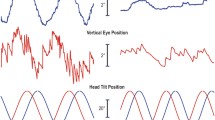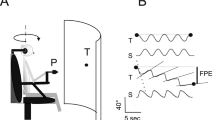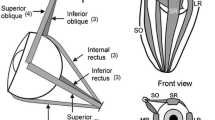Summary
Orbital motion of the head with the face directed towards the axis of rotation is a stimulus to the otolith organs which is in the opposite rightwards-leftwards sense to the rotational stimulus to the semicircular canals. This can be experienced, for example, by a child held at arms length “en face” and swung from side to side. As one swings, say to the right, the child's head rotates to its right yet moves linearly to its left. Eye movement responses to a transient orbital movement were observed whilst subjects fixated earth-fixed targets, i) a “near target” placed between the head and the axis whose relative displacement is in the same direction as head rotation, and ii) a “far target” placed beyond the axis whose relative motion is in the opposite direction to head rotation. The motion stimuli evoked slow phase eye movements at 45 ms latency, always in the opposite direction to head rotation, thus compensating for the motion of the far target but in the wrong direction for fixating the near target. Theoretically, fixating the near target demands a predominance of the otolith ocularreflex, which would give an eye movement in the correct direction. However, despite visual cues, it seems that if the canal and otolith-ocular reflexes are evoked in opposing directions, the otolith reflex fails to operate at a sensitivity sufficiently high to reverse the direction of the canal-reflex.
Similar content being viewed by others
References
Baloh RW, Beykirch K, Honrubia V, Yee RD (1988) Eye movements induced by linear acceleration on a parallel swing. J Neurophysiol 60:2000–2014
Barnes G (1980) Vestibular mechanisms (review article). Clin Phys Physiol Meas 1:3–40
Bronstein AM, Gresty MA (1988) Short latency eye movement responses to transient linear head acceleration: a specific function of the otolith-ocular reflex. Exp Brain Res 71:406–410
Buizza A, Leger A, Droulez J, Berthoz A, Schmid R (1980) Influence of otolithic stimulation by linear acceleration on optokinetic nystagmus and visual motion perception. Exp Brain Res 39:165–176
Gresty MA, Bronstein AM (1986) Otolith stimulation evokes compensatory reflex eye movements of high velocity when linear motion of the head is combined with concurrent angular motion. Neurosci Lett 65:149–154
Gresty MA, Bronstein AM, Barratt HJ (1987) Eye movement responses to combined linear and angular head movement. Exp Brain Res 65:377–384
Page GD (1989) The influence of target distance on eye movement responses during vertical linear motion. Exp Brain Res 65:377–384
Schwartz U, Busettini C, Miles FA (1989) Ocular responses to linear motion are inversely proportional to viewing distance. Science 245:1394–1396
Takeda N, Igarashi M, Koizuka I, Chae S, Matsunaga T (1990) Recovery of the otolith-ocular reflex after unilateral deafferentation of the otolith organs in squirrel monkeys. Acta Otolaryngol (Stockh) 110:25–30
Viirre E, Tweed D, Milner K, Villis T (1986) A re-examination of the gain of the VOR. Neurophysiology 56:439–450
Author information
Authors and Affiliations
Rights and permissions
About this article
Cite this article
Bronstein, A.M., Gresty, M.A. Compensatory eye movements in the presence of conflicting canal and otolith signals. Exp Brain Res 85, 697–700 (1991). https://doi.org/10.1007/BF00231756
Received:
Accepted:
Issue Date:
DOI: https://doi.org/10.1007/BF00231756




